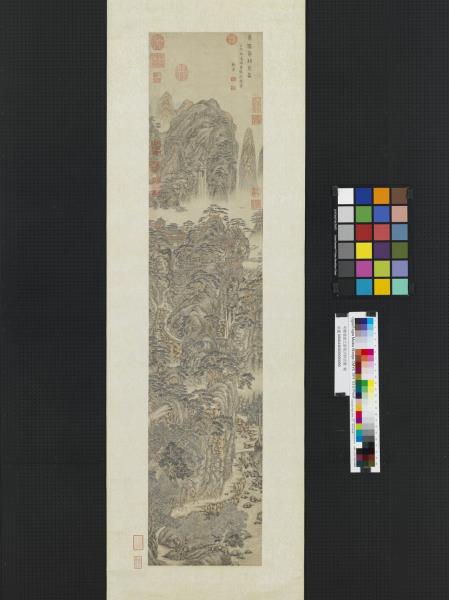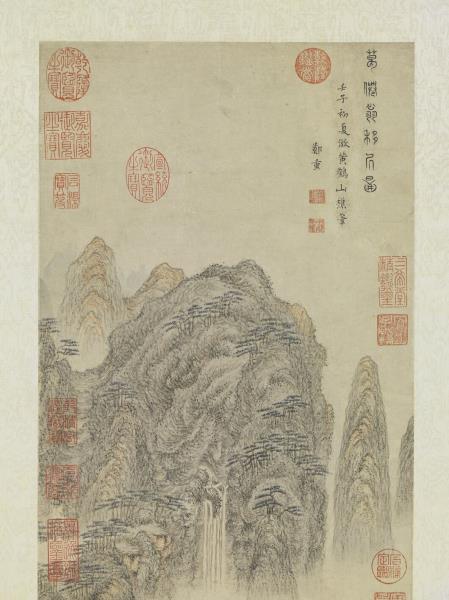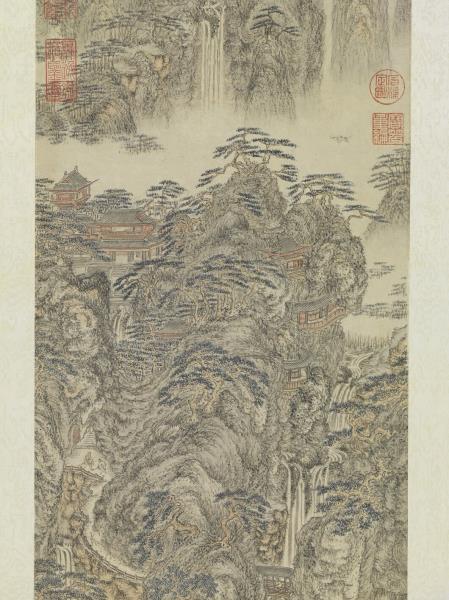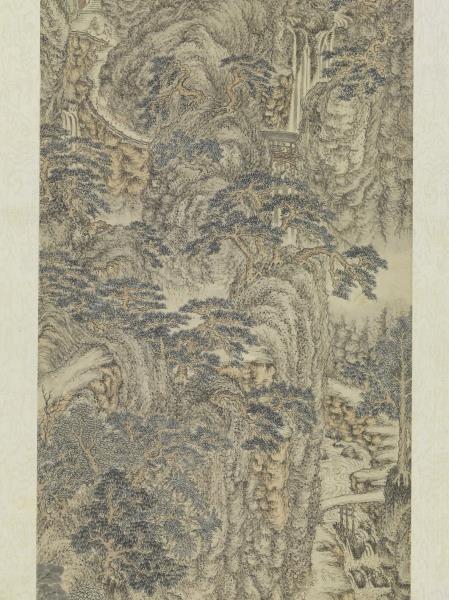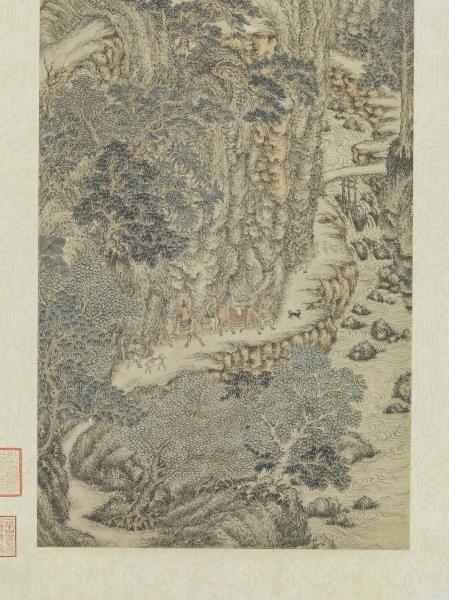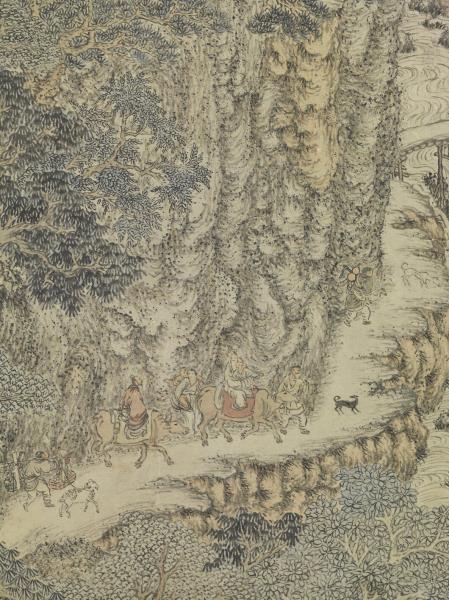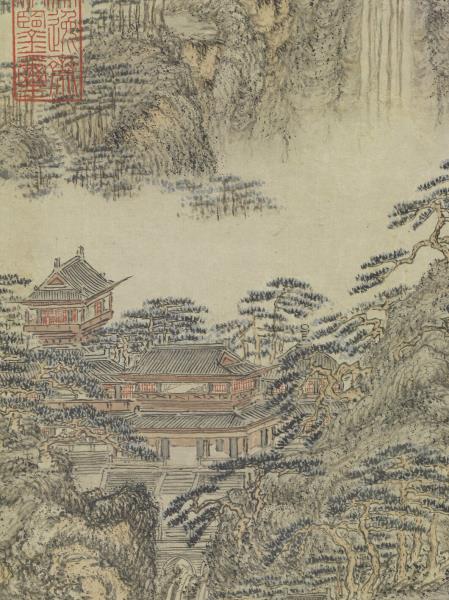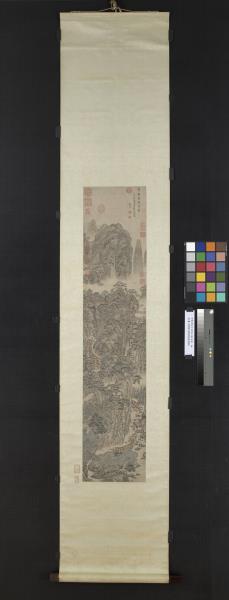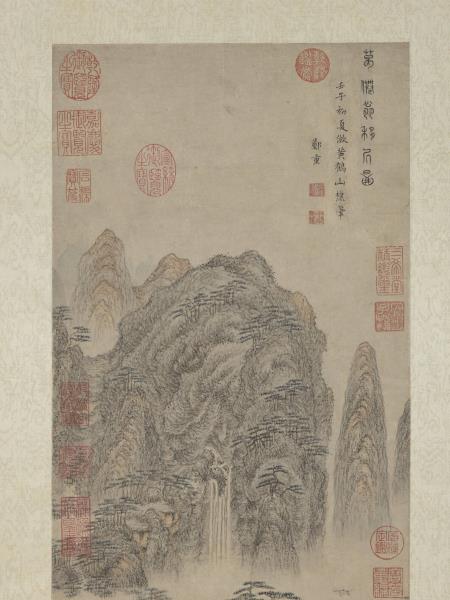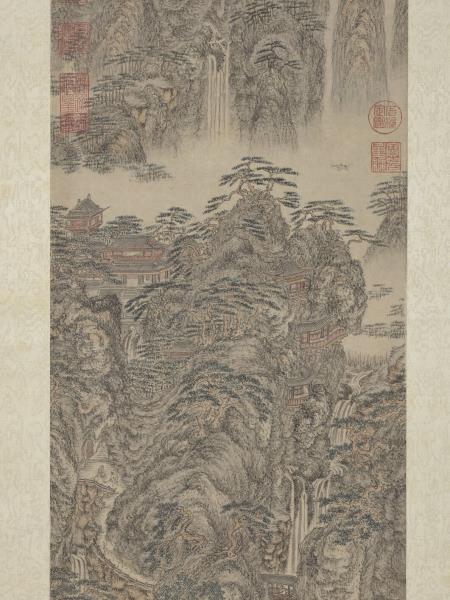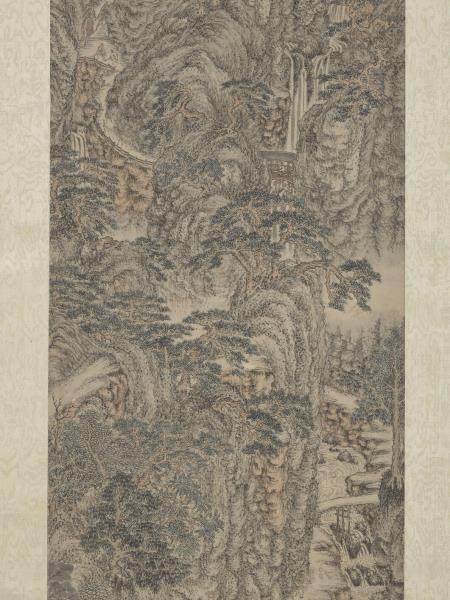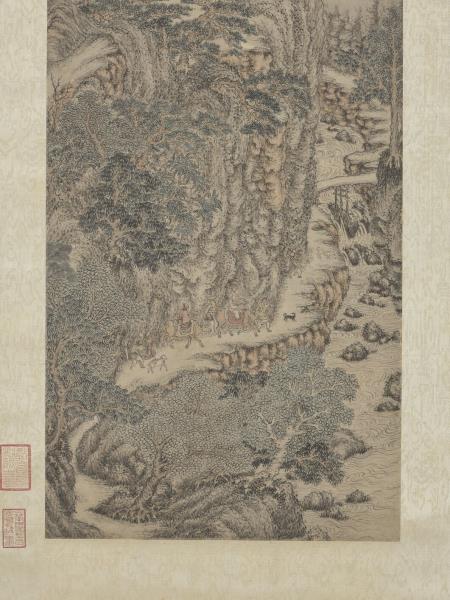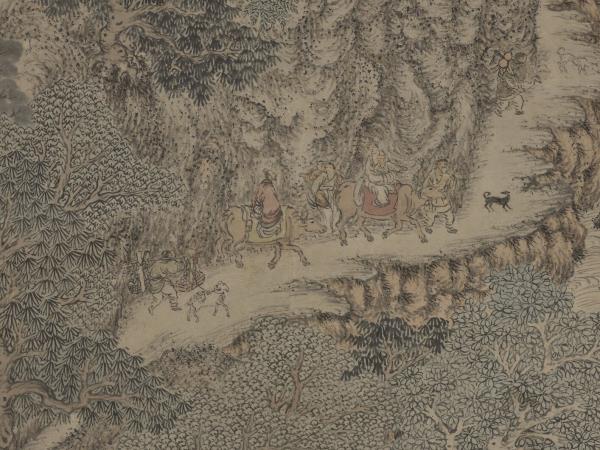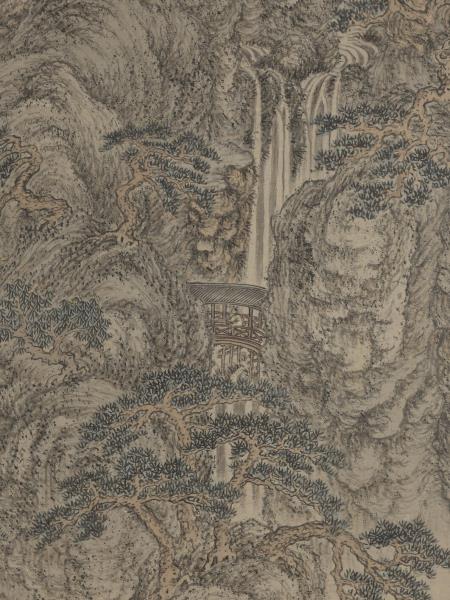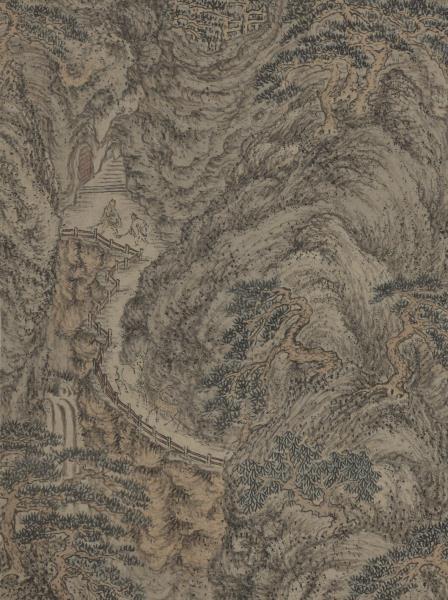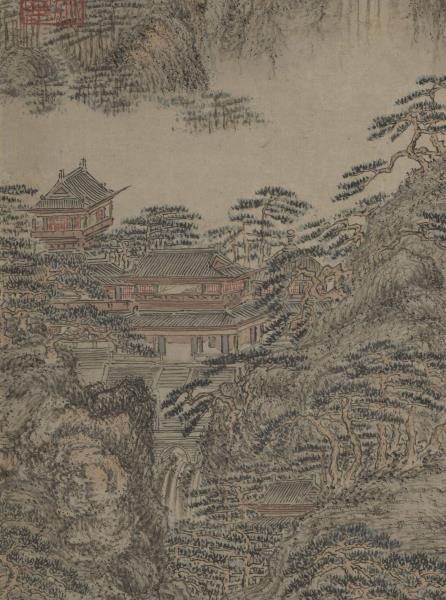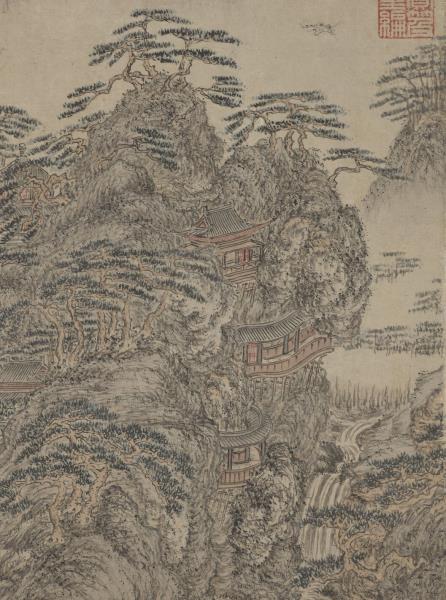| 文物統一編號 |
故畫000644N000000000
|
| 作品號 |
故畫00064400000 |
| 品名 |
明鄭重倣王蒙葛洪移居圖 軸
Imitating Wang Meng’s “Ge Hong Moving” |
| 分類 |
繪畫 |
| 作者 |
鄭重,Zheng Zhong |
| 創作時間 |
明神宗萬曆四十年(1612) |
| 數量 |
一軸 |
| 題跋類別 |
作者 |
位置 |
款識 |
書體 |
全文 |
| 作者款識 |
鄭重
印記 expand_more
|
本幅 |
葛仙翁移居圖。(篆書)。壬子(西元一六一二年)初夏。倣黃鶴山樵筆。鄭重。(楷書)。 |
篆書 |
|
|
|
| 印記類別 |
印主 |
印記 |
| 鑑藏寶璽 |
清內府印 |
三希堂精鑑璽 |
| 鑑藏寶璽 |
清高宗 |
石渠定鑑 |
| 鑑藏寶璽 |
清內府印 |
石渠寶笈 |
| 鑑藏寶璽 |
清內府印 |
宜子孫 |
| 鑑藏寶璽 |
宣統帝 |
宣統御覽之寶 |
| 鑑藏寶璽 |
宣統帝 |
宣統鑑賞 |
| 鑑藏寶璽 |
清高宗 |
乾清宮鑑藏寶 |
| 鑑藏寶璽 |
清高宗 |
乾隆御覽之寶 |
| 鑑藏寶璽 |
清高宗 |
乾隆鑑賞 |
| 鑑藏寶璽 |
清高宗 |
無逸齋精鑑璽 |
| 鑑藏寶璽 |
清仁宗 |
嘉慶御覽之寶 |
| 鑑藏寶璽 |
清高宗 |
寶笈重編 |
| 主題類別 |
主題(第一層) |
主題(第二層) |
主題說明 |
| 主要主題 |
山水 |
|
|
| 主要主題 |
經史‧故事 |
|
葛洪移居 |
| 次要主題 |
人物 |
高士(士人、隱士) |
葛洪 |
| 次要主題 |
山水 |
瀑布 |
|
| 次要主題 |
佛道人物 |
道(道士、道姑) |
葛洪 |
| 次要主題 |
建築 |
臺閣 |
|
| 次要主題 |
建築 |
橋 |
|
| 其他主題 |
人物 |
仕女 |
|
| 其他主題 |
人物 |
侍從(侍女、童僕) |
|
| 其他主題 |
人物 |
孩童 |
|
| 其他主題 |
山水 |
山徑 |
|
| 其他主題 |
山水 |
溪澗、湍泉 |
|
| 其他主題 |
走獸 |
牛 |
|
| 其他主題 |
走獸 |
羊 |
|
| 其他主題 |
走獸 |
狗 |
|
| 其他主題 |
走獸 |
鹿 |
|
| 其他主題 |
建築 |
房舍 |
|
| 其他主題 |
建築 |
迴廊 |
|
| 其他主題 |
建築 |
欄杆 |
|
| 其他主題 |
翎毛 |
鵝 |
|
| 其他主題 |
翎毛 |
鶴 |
|
| 其他主題 |
樹木 |
|
|
| 其他主題 |
樹木 |
松 |
|
| 技法 |
技法細目 |
| 人物衣紋描法(勻稱線條) |
|
| 苔點 |
|
| 皴法 |
|
| 皴法 |
披麻皴 |
| 類別 |
參考資料 |
| 內容簡介 |
鄭重(十七世紀前期),字千里,號無著,安徽歙縣人,後流寓金陵。善寫佛像,亦畫山水小景,摹仿宋、元體均精妍。
葛洪,晉句容人。自號抱朴子,習煉丹術於鄭隱,後聞交趾出丹砂,攜子姪赴羅浮山煉丹,丹成尸解。
本幅描繪葛洪移居情景。布居窄長,用筆仿王蒙之焦墨、渴苔,設色清雅。題材雖屬道教故實,然人物比例遠遜於山川林屋,觀此畫例,足證元明以降,山水畫已蔚成國畫作之主導。
|
| 內容簡介 |
鄭重,字千里,號無著,安徽歙縣人,流寓金陵。活動於晚明清初。好樓居,日事香茗,善寫佛像,必齋沐而後舉筆。丁雲鵬推為趙伯駒後身,亦畫山水小景,摹仿宋、元,體均精妍。
本幅設色畫。鮑靚懷嬰兒前行,葛洪後,俱騎牛,各一童執靷,一童擔家具,一童捧鵝背藥瓢。又有一羊二大。按葛洪,鮑靚均為晉時人,修行道教。畫中山巒層層,用筆茂密,正是王蒙風格,點景人物,亦生動活潑。
|
| 內容簡介 |
繪道教故實晉代著名道士葛洪移居情景。葛洪為晉朝句容人,自號抱朴子,習煉丹術於鄭隱,後聞交趾出丹砂,攜子姪赴廣東羅浮山煉丹。畫中妻子鮑氏懷抱孩童,葛洪在後,俱騎牛。一童牽牛,一童擔家具,一童捧鵝背藥瓢。又有一羊二犬。畫中山巒層層,用筆茂密,正是王蒙風格,點景人物,亦生動活潑。
鄭重(十七世紀前期)字千里,號無著,安徽歙縣人,流寓金陵。善寫佛像,亦畫山水。(20091016)
|
| Description |
This work depicts the famous Daoist Ge Hong (283-343) moving home. Native to Jurong, Ge learned the art of alchemy from Zheng Yin. Later he heard of cinnabar in Jiaozhi in the far south, taking his family to Mt. Luofu in Guangdong to make the elixir of transcendence. Here, he is on an ox behind his wife (née Bao) and child. An attendant leads an ox, one has the furniture, and another holds a goose and a gourd of medicine. There is also a ram and two dogs. The layers of peaks were done with dense brushwork, much in Wang Meng’s (1308-1385) style, as the figures add life to the work. Zheng Zhong (style name Qianli; sobriquet Wuzhu) was a native of Shexian, Anhui, who resided in Jinling. He excelled at Buddhist subjects and landscapes.(20091016)
|
| Description |
Cheng Chung was a native of Anhui. He excelled in Buddhist painting. Whenever he drew Buddhist paintings, he must have purified himself by observing rules of abstinence and bathing. Ting Yun-p’eng praised Cheng as an incarnation of Chao Po-chu, who was a renowned figure painter of the Sung dynasty. He was also noted for his small landscape paintings and paintings after the styles of Sung and Yuan masters.
This painting is in color. Pao Ch’ien, a female Taoist, carrying a baby moves forward, and Ko Hung, also a Taoist, follows. Additionally, there are a ram, two dogs, and three boys seizing a lether belt of an ox, carrying furniture, and holding a goose with two hands and carrying a medicine bottle on the back respectively. Thick layers of mountains and dense brushwork of this painting recall characteristics of Wang Meng’s works. The figures in this painting are lively and animated.
|
| Description |
Cheng Chung, a native of Hsi Hsien, Anhwei Province, was also called by his tzu (style name) Ch'ien-li and by his hao (sobriquet) Wu-cho. He was famous for painting Buddhist figures and landscape. In imitating the styles of Sung Yuan paintings, Cheng Chung successfully captured them with refined delicacy. Ko Hung was a reknowned Taoist of the Chin dynasty (265-420). He called himself Pao-p'u Tzu and learned from Cheng Yin the Taoist skill of refining elixir of life. Later when Ko Hung heared that there were great products of cinnabar in Chiao-chih (northern Vietnam), he moved his residence there and settled down in Mountain Lo-fu to practice the skill of refining elixir. Finally, he attained perfeftion in Taoism there.
In this painting, the artist depicts the scene of Ko Hung and his family traveling on the road to Mountain Lo-fu. The elongated composition, brushwork and color rendering are obviously after the style of the Yuan master Wang Meng. Though the main theme of this picture is a Taoist story,the landscape is proportionately represented than the figures; this proves that after the Yuan dynasty landscape already developed as a leading catagory in Chinese painting history.
|
| 收藏著錄 |
石渠寶笈續編(乾清宮),第一冊,頁443
|
| 收藏著錄 |
故宮書畫錄(卷五),第三冊,頁475
|
| 收藏著錄 |
故宮書畫圖錄,第九冊,頁189-190
|
| 參考書目 |
許文美,〈明鄭重倣王蒙葛洪移居圖 軸〉,收入《何處是蓬萊-仙山圖特展》(臺北:國立故宮博物院,2018.06),頁96-97、167-168。
|
本院文物保存維護依〈國立故宮博物院典藏文物管理作業要點〉及〈國立故宮博物院文物修護業務作業原則〉辦理
抽盤點紀錄
修護紀錄


